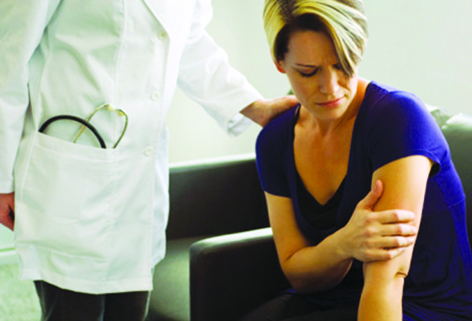Most of the time, blood clots are a good thing. When you get injured, you need your blood to solidify and clump together at the site to help stop the bleeding. But sometimes clots crop up when they’re not needed, and that can spell trouble—especially if they form in the deep veins near your muscles.
“When blood clots form in this deeper system, they can be painful and very dangerous,” says Luis Navarro, M.D., founder of the Vein Treatment Center in New York City. This kind of clot is called a deep vein thrombosis, or DVT. They’re like roadblocks on your blood highway, causing traffic jams in your circulation and prevent the blood flow that keeps your system up and running.
Swelling in one limb
A swollen leg or arm is one of the most common signs of a DVT. “Blood clots can block the healthy flow of blood in the legs, and blood can pool behind the clot causing swelling,” says Dr. Navarro.
It’s normal to overlook leg swelling as a symptom of a DVT if you always get large or stiff legs when you fly or during periods of immobility. But be suspicious if your bloated limb comes on quickly, especially if it shows up with a side of pain.
Leg or arm pain
Usually, DVT pain comes as a combo with other symptoms like swelling or redness, but sometimes it can stand alone.
“Unfortunately, pain from a blood clot can easily be mistaken for a muscle cramp or strain, which is why the issue often goes undiagnosed and is specifically dangerous,” says Dr. Navarro.
DVT pain tends to strike when you’re walking or when you flex your foot upward. If you have a charley horse you can’t seem to shake—especially if the skin near it is warm or discolored—have your doctor take a look.
Redness on your skin
While it’s true that a bruise is a type of blood clot, it’s not the kind you have to worry about. You can’t see a DVT. You might see some bruise-like discoloration, but you’re more likely to see red. A DVT causes redness in the affected limb and makes your arm or leg feel warm to the touch.
Chest pain
A pain in your chest may make you think heart attack, but it could be a pulmonary embolism. “Both a PE and a heart attack share similar symptoms,” says Dr. Navarro. However, PE pain tends to be sharp and stabbing, and feels worst when you take a deep breath.
Heart attack pain often radiates from upper areas of your body like your shoulders, jaw, or neck. The biggest clue is in your breathing—PE pain gets steadily worse with every breath you take.
Shortness of breath
A blood clot in your lung slows your oxygen flow, and that can leave you feeling winded. “You often won’t have the stamina or breath to make it up stairs. You feel lousy,” says George P. Teitelbaum, M.D., interventional neuroradiologist and director of the Stroke & Aneurysm Center at Providence Saint John’s Health Center in Santa Monica, Calif. Get help quickly, especially if this comes on suddenly.
Unexplained cough
Can’t stop hacking? If you’re also having shortness of breath, fast heart rate, or chest pain, it could be a PE. “The cough will be dry, but sometimes people can cough up mucus and/or blood,” says Dr. Navarro. When in doubt, phone your doc or go straight to the ER.
